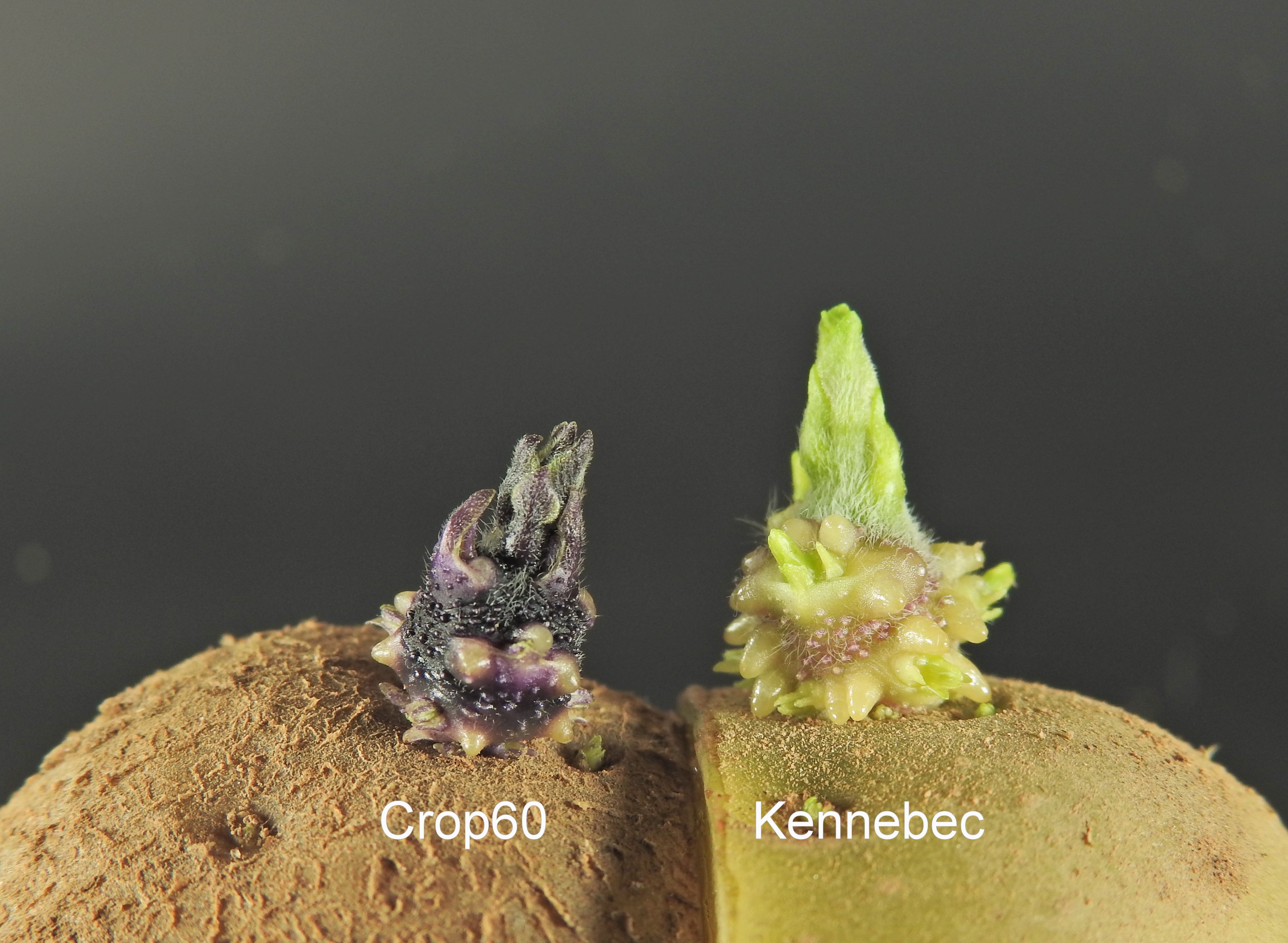Crop60
| Denomination: | 'Crop60' |
|---|---|
| Botanical Name: | Solanum tuberosum |
| Applicant/Holder: |
The New Zealand Institute for Plant and Food Research Ltd. 120 Mt. Albert Road Mt. Albert Auckland 1025 New Zealand |
| Breeder: |
The New Zealand Institute for Plant and Food Research Ltd., Auckland, New Zealand |
| Agent in Canada: |
McCain Produce Inc. 8734 Main Street Unit 1 Florenceville-Bristol, New Brunswick E7L 3G6 Canada Tel: 506-392-2893 |
| Application Date: | 2020-09-21 |
| Provisional Protection:: | 2020-09-21 |
| Application Number: | 20-10354 |
Variety Description
Variety used for comparison: 'Kennebec'
Summary: The base of the lightsprout of 'Crop60' has a very strong intensity of anthocyanin colouration with a high proportion of blue while that of 'Kennebec' has a weak to medium intensity of anthocyanin colouration with a medium proportion of blue. The stem of 'Crop60' has a medium extent of anthocyanin colouration on the lower three quarters of the stem while that of 'Kennebec' has an absent or very low extent of anthocyanin colouration along the entire stem. The second pair of lateral leafets of 'Crop60' are medium sized while those of 'Kennebec' are very large. The plants of 'Crop60' are taller than those of 'Kennebec'. The tuber of 'Crop60' has reddish brown skin and shallow eyes while the tuber of 'Kennebec' has light beige skin and eyes of medium depth.
Description:
LIGHTSPROUT: small to medium sized, spherical, few to a medium number of root tips, short lateral shoots
LIGHTSPROUT BASE: very strong intensity of anthocyanin colouration, high proportion of blue in anthocyanin colouration, absent or very sparse to sparse pubescence
LIGHTSPROUT TIP: medium sized in relation to base, closed habit, very strong intensity of anthocyanin colouration, medium density of pubescence
PLANT: intermediate to leaf type foliage structure where foliage is half open to closed and stems are partly to hardly visible, semi-upright growth habit, low frequency of flowers, matures mid to late season
STEM: medium extent of anthocyanin colouration on the lower three quarters of the stem
LEAF: small to medium sized outline, openess is intermediate to open, weak to medium presence of secondary leaflets, medium green upper side, absent or very low to low extent of weak intensity anthocyanin colouration on upper side of midrib, absent or very low frequency of coalescence of terminal and lateral leaflets
SECOND PAIR OF LATERAL LEAFLETS: medium sized, leaflet is narrower than long
LEAFLET: absent or very weak degree of waviness of margin, medium depth of veins, dull on upper side, pubescence absent on blade at apical rosette
PEDUNCLE: absent or very low extent of anthocyanin colouration
INFLORESCENCE: medium sized
FLOWER BUD: absent or very low extent of anthocyanin colouration
COROLLA: medium sized
COROLLA (INNER SIDE): absent or very low extent of absent or very weak intensity anthocyanin colouration, absent or low proportion of blue in anthocyanin colouration
TUBER: long oval, white flesh
TUBER EYE: shallow, yellow at base
TUBER SKIN: reddish brown, absent or very weak to weak intensity of anthocyanin colouration in reaction to light
Origin & Breeding History: 'Crop60' originated from a cross conducted between 'Apassionate' as the female parent and 'Karaka' as the male parent at The New Zealand Institute for Plant & Food Research Limited in Lincoln, New Zealand in 2004. Seed from the cross was grown in a greenhouse in 2005 to 2006 with resulting tubers planted in a field in Lincoln, New Zealand in 2006. Selections were conducted through 8 generations with 'Crop60' being selected in 2013 based on qualities for french fry production.
Tests & Trials: The comparative trial for 'Crop60' was conducted by Global Agri Services Inc. in Central Blissville, New Brunswick during the 2021 growing season. The field trial consisted of a single, 20 metre long row per variety. Each row contained 65 plants spaced 0.3 metres apart with inter-row spacing of 1.1 metres. Measurements were taken from 10 plants, or 10 parts of plants, of each variety. The mean difference was significant at the 5% probability level based on a paired Student's t-test. Lightsprout characteristics were assessed on 10 tubers harvested from the comparative trial and observed approximately 2.5 to 3 months after sprouting was promoted by exposing the tubers to an external agent.
Comparison table for 'Crop60' with reference variety 'Kennebec'
Plant height (cm)
| 'Crop60' | 'Kennebec' | |
|---|---|---|
| mean | 59.5 | 44.0 |
| std. deviation | 3.7 | 2.1 |
Click on image for larger view

Potato: 'Crop60' (left) with reference variety 'Kennebec' (right)
- Date modified: